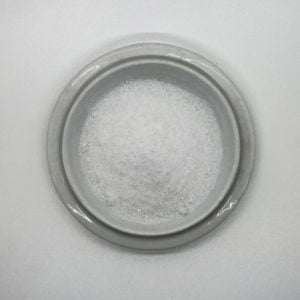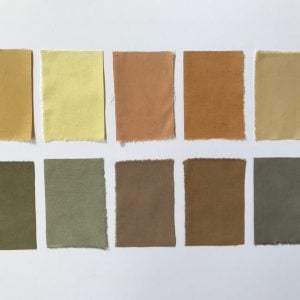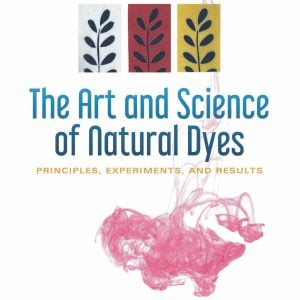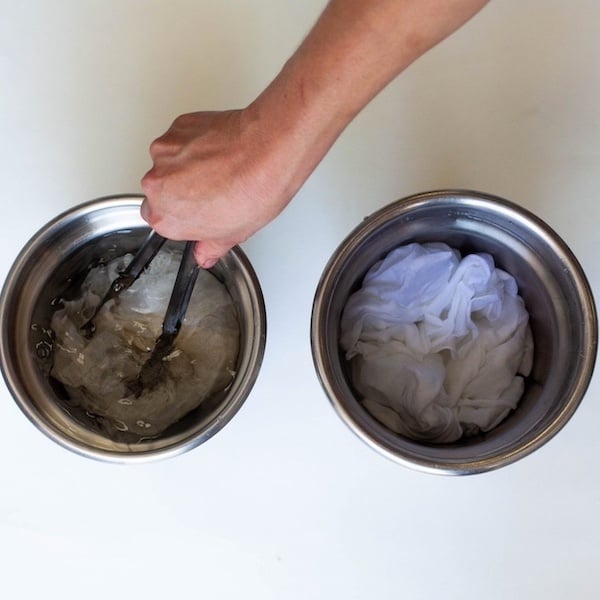
Our How To guides are intended to make the mordant process easy, from scouring your fibers to dyeing with an assortment of dyes. You can find other How To guides here.
What is Mordanting?
Mordanting is the most important process of preparing fibers to accept color. Using a mordant helps to ensure the most durable and long-lasting colors. With the exception of indigo (as a vat dye, it does not require a mordant), this is not an optional step.
Mordanting provides the dyer flexibility as fibers can be mordanted in advance, dried, and dyed later, or mordanted and dyed in one day. Drying and storing, or “curing” alum-mordanted fibers often results in deeper shades on wool and silk. If you are new to natural dyeing, we recommend starting with wool fiber as it is the easiest to dye.
(Check out our recent Q & A: Round Up of Mordanting + Scouring 101 here.)
Most mordants are calculated based off of a percentage of the weight of fiber. Weight of fiber (WOF) refers to the dry weight of the yarn or fabric to be mordanted. It is used primarily when weighing mordants and dyes and allows you to quickly and easily calculate how much to measure. Therefore, a kitchen scale is handy to determine the weight of yarns or fabrics.
Mordanting with Aluminum Potassium Sulfate
Aluminum potassium sulfate is a wonderful mordant to use with protein (animal-based) fibers. It is typically a heated process but can be used cold if you are mordanting wool fibers. See below for the cold water instructions.
Cream of tartar can also be used as an optional addition when mordanting wool. Its purpose is to assist the alum to bond with the wool and it also keeps wool fibers soft. Bear in mind that it will shift colors, and in some cases, can inhibit the development of certain shades. For example, logwood is particularly sensitive when cream of tartar is added and can shift from purple to brown.
Calculating the amount of mordant
Aluminum potassium sulfate: the recommended amount of aluminum potassium sulfate is 10% WOF. Note that you can go up to 20% WOF. A higher percentage mordant of the WOF results in deeper shades with many colors, especially red dyes.
Cream of tartar: the amount of cream of tarter should be 6% WOF. You can use aluminum potassium sulfate and cream of tartar together; the cream of tartar brightens many colors and helps keep wool fibers soft.
Safety instructions
We advise wearing a dust mask or respirator, gloves, and an apron with all powders as they can be irritating to the nose, throat, and skin. Aluminum potassium sulfate is considered non-toxic but still should be handled with care as it is astringent and drying to skin. We strongly recommend adult supervision if working with children.
We also recommend that you keep dye tools and utensils separate from kitchen tools and work with plenty of ventilation. Alum may be safely disposed in a municipal water system by pouring down the drain. Do not dispose of in waterways or drains that flow into waterways.
You will need
This list of ingredients is for 100 grams (4 ounces) of fiber, and with 20% aluminum potassium sulfate for a deeper shade. Adjust the amount of materials as necessary, per the percentage guidelines above.
- 100 grams/4 ounces fiber
- 20 grams/.8 ounces aluminum potassium sulfate
- A container to dissolve the aluminum potassium sulfate
- A large stainless steel dye pot
- Optional: Heat source
- Optional: 6 grams/.25 ounces cream of tartar
- Dye rings (if dyeing skeins of yarn)
Measure the aluminum potassium sulfate and pour it into a container that you can pour hot water into and mix it. Bring about a cup of water to a boil, and pour it into the container to dissolve the aluminum potassium sulfate. If using cream of tartar, dissolve separately.
Fill a dye pot with room temperature water, place on a heat source, then add the dissolved aluminum potassium sulfate (and cream of tartar) to the pot and stir well.
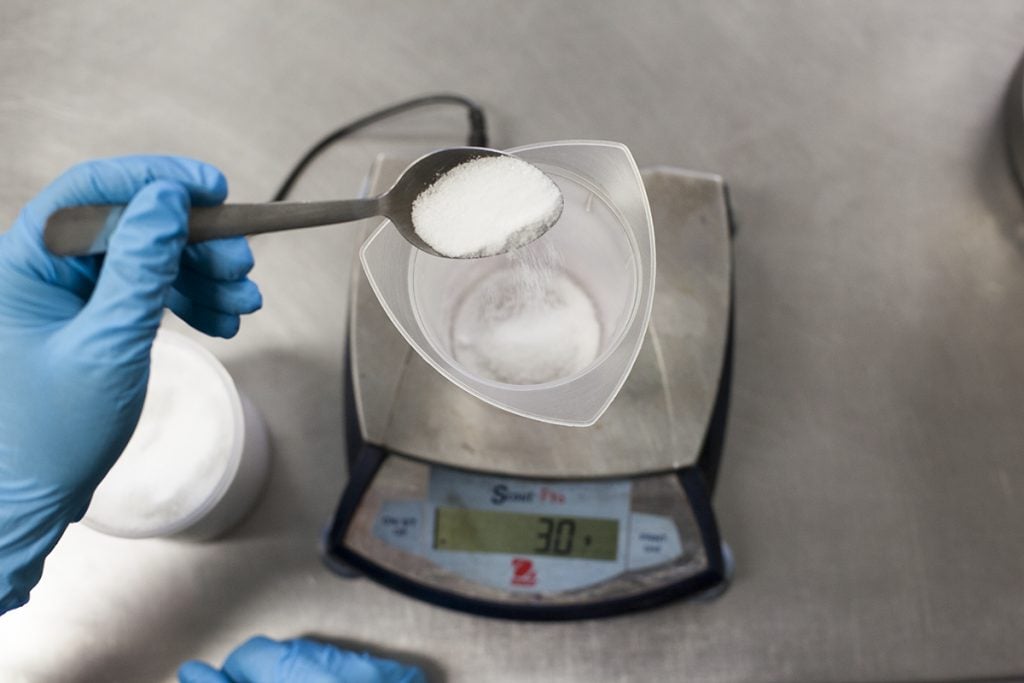
Add the fiber to the pot, rotating the fibers gently. Make sure there are no bubbles under fabric folds, or that any yarn is floating. Slowly bring the temperature up to 180°F and hold for 45 minutes. Rotate the fibers occasionally and gently.
Allow to cool briefly, and then remove fibers from the dye pot. You may also leave the fibers in the mordant solution overnight to cool, then remove excess water. Some dyers feel this increases the depth of shade in the finished piece.
Rinse in similar temperature water, remove excess water from the fibers, and proceed to dyeing.

Cold water mordanting instructions for wool
Measure and dissolve your aluminum potassium sulfate as directed above.
Fill a pot large enough for your fibers to move freely with warm water and add the mordant.
Add the fiber to the pot, rotating them gently. Make sure there are no bubbles under fabric folds, or that any yarn is floating.
Leave the fibers in the mordant bath for at least four days.
Rinse in similar temperature water, remove excess water from the fibers, and proceed to dyeing.
Reusing the mordant bath to save water and alum
Many dyers will reuse their aluminum potassium sulfate bath for multiple mordant sessions to save water and mordant. You may reuse aluminum potassium sulfate baths at least twice. To recharge the bath, add about 25% additional dissolved aluminum potassium sulfate, stir and mordant as above. If you observe excessive cloudiness or large flakes floating in the bath, it is time to change it.
Storing mordanted fibers
Mordanted fibers may be stored damp in a plastic bag and refrigerated for 3-5 days and cured or aged, as this also seems to increase the depth of shade in the dyed fibers. Curing normally produces a deeper color, but be aware that fibers mordanted with alum and cream of tartar can get moldy if they are stored longer than a week while damp. For longer storage, mordanted fibers may be air dried and stored for future use. Label and store your mordanted fiber and keep it away from dust or dye powders, as it is vulnerable to staining. My unscientific experiments show that mordanted animal fibers hold the mordant for 5+ years, while silk seems to hold it for about a year or two.
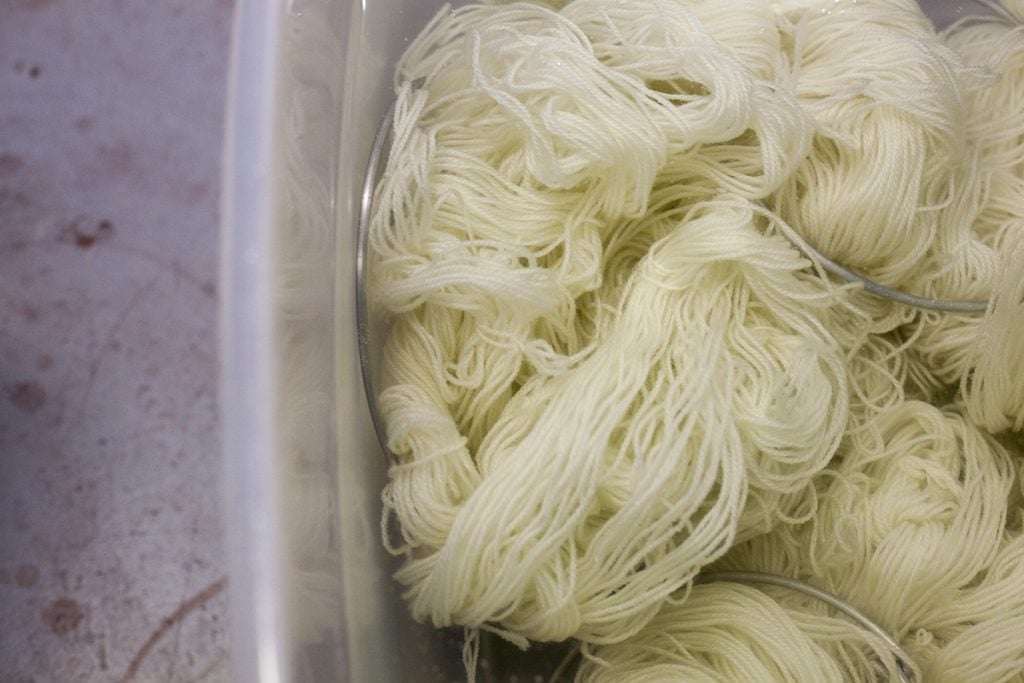
You might also like to read:
Q & A: Round Up of Mordanting + Scouring 101
Video of Live Q&A For (New Cold Water Mordant) Aluminum Triformate
Our weekly Mordant Monday series!

